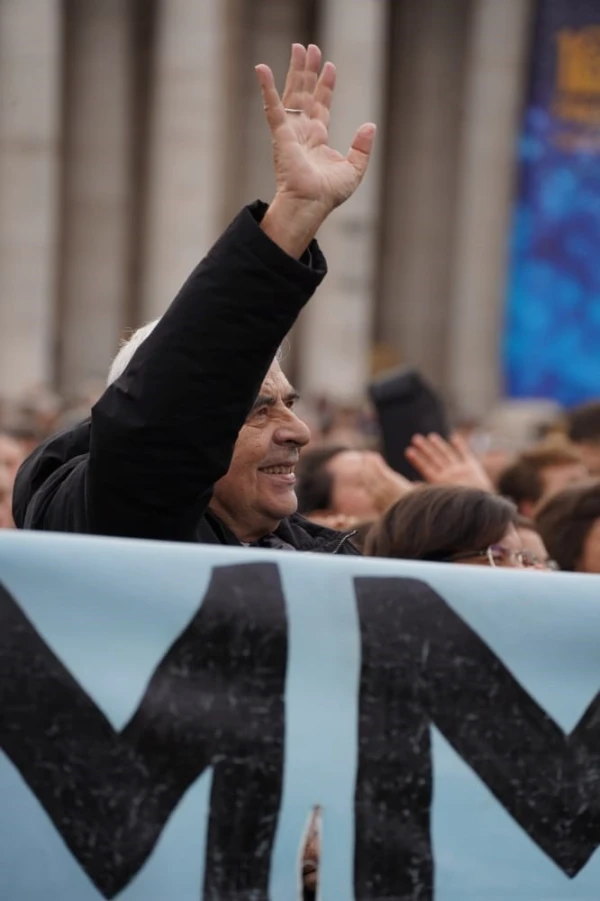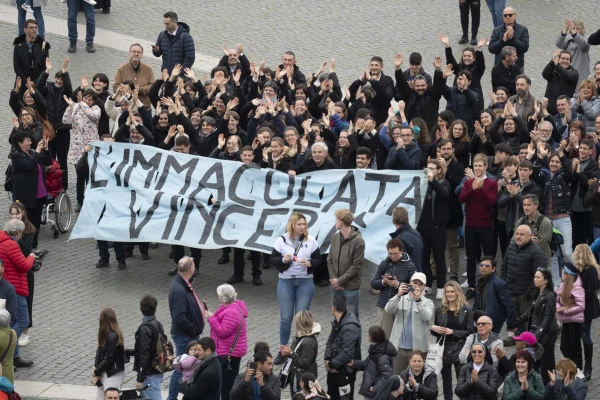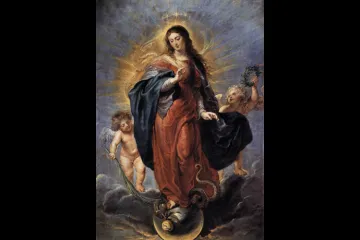Vatican City, Dec 8, 2023 / 15:30 pm
“The Immaculate Conception will triumph”: These are the words displayed, in Italian, on a blue banner held every week in St. Peter’s Square during the Angelus — a prayer honoring Mary — for 29 years.
The banner’s declaration recalls the Marian spirituality of St. Maximilian Kolbe, who had a special devotion to the Immaculate Conception.

Since the feast of the Immaculate Conception on Dec. 8, 1994, members of the Casa di Maria (“House of Mary”) community have held the sign “L’Immacolata Vincerà” at the pope’s Angelus on Sundays and Marian feast days.
“Every time we hold the banner in the square we affirm that life is a struggle and the Christian’s joy is a victory … the joy not of those who pretend that all is well but the exultation of those who believe that evil does not have the last word because God is greater,” Father Michele Reschini told CNA via email.
The priest, who oversees the community’s youth formation, said the House of Mary is inspired to be present at the Angelus every Sunday as a sign of its filial affection for the pope and support for his magisterium and apostolate.
“Moreover, this banner is meant to be a small sign of a great hope,” he explained. “In such an ecclesial place and moment as the Angelus in St. Peter’s Square we want to express that Our Lady is present in the heart of the Church.”
There are frequently tens of thousands of people in attendance at the Sunday Angelus with Pope Francis.
The custom of popes publicly praying the Angelus at midday on Sundays goes back to 1954, when Pope Pius XII was convinced to do so by his friend, Italian Catholic doctor and lay leader Luigi Gedda.
The House of Mary community, founded in 1990, was supported in its early days by Cardinal Andrzej Maria Deskur, a Polish cardinal working in the Vatican and a friend of St. John Paul II from his seminary days.

Originally a Marian prayer group, the community is made up of priests, consecrated women, families, and young adults.
Deskur had written about St. Maximilian Kolbe and his Marian spirituality in a meditation for a novena to the Immaculate Conception in 1987.
“The Mariology of St. Maximilian Mary Kolbe could be summarized in the phrase frequently repeated by the saint in the face of the difficulties he encountered: ‘The Immaculate Conception will triumph,’” the cardinal wrote.
Deskur invoked the phrase again in a March 25, 1994, audience with John Paul II, to whom he presented the House of Mary community and its founder, Father Giacomo Martinelli.
“The Immaculate Conception will triumph” became the unofficial motto of the House of Mary, and almost nine months later, on Dec. 8, 1994, the group brought their blue banner, for the first time, to the Angelus in St. Peter’s Square.
(Story continues below)
At an Angelus the following month, Pope John Paul II pointed to the sign and said, “I, too, am convinced that the Immaculate Conception will triumph!”
Over the years, the group has also brought its banner on some of the pope’s apostolic trips within Italy, estimating that it has traveled more than 96,000 miles to over 38 cities.
Pope Francis has also been supportive of the group and its presence at his Sunday Angelus.
“The House of Mary is a community that wants to live the Gospel in faith and to witness to the Gospel through fraternal life in a world that increasingly loses the gift of belief and the gift of fraternity,” Reschini said.
“Our Lady has always been present in the life of Jesus, from the manger to Calvary. So she is always present in the life of the Church, from its beginning to its end,” he continued. “This faithfulness of hers gives us hope, this presence of hers is a guarantee of victory. It impels us to believe that his faithfulness is stronger than our infidelities, and in this faithfulness the Church can always find herself faithful to Jesus Christ.”
“Inside the storms of modern times; in the midst of the icy winds of secularism, modernism, and relativism; under the threats of apostasy and idolatry, the Church remaining with Mary will triumph, will triumph because like Mary and with Mary, it is faithful to Christ to the end.”






